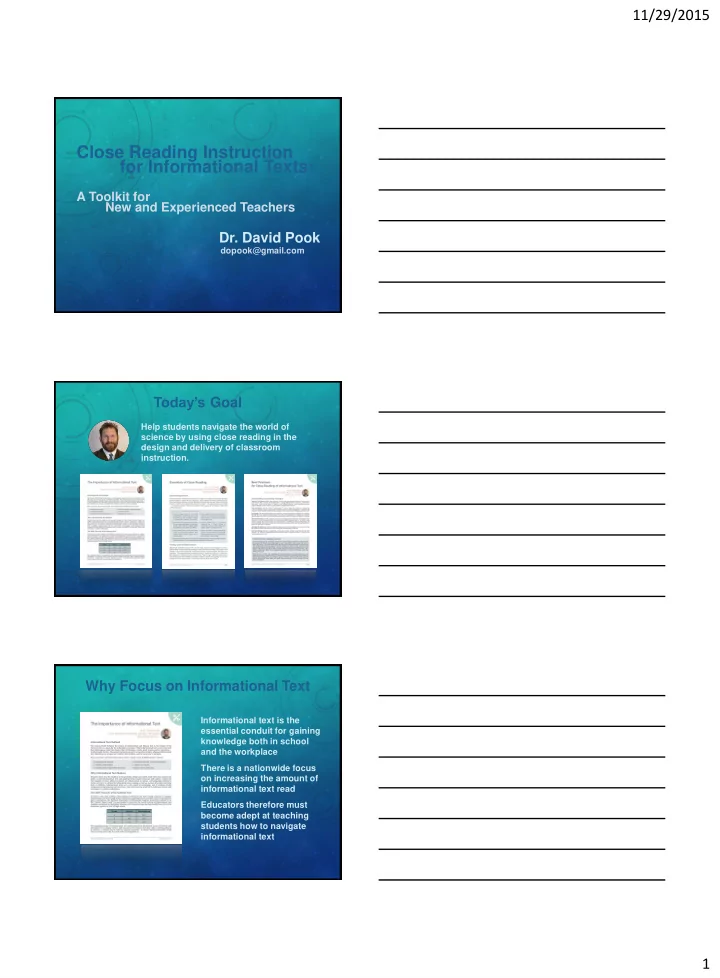

11/29/2015 Close Reading Instruction for Informational Texts: A Toolkit for New and Experienced Teachers Dr. David Pook dopook@gmail.com Today’s Goal Help students navigate the world of science by using close reading in the design and delivery of classroom instruction. Why Focus on Informational Text Informational text is the essential conduit for gaining knowledge both in school and the workplace There is a nationwide focus on increasing the amount of informational text read Educators therefore must become adept at teaching students how to navigate informational text 1
11/29/2015 What Close Reading Looks Like Close reading asks students to examine how words unfold on the page by answering text dependent questions These questions involve identifying what the text says explicitly as well as what can be inferred from it Teachers use close reading to drive students back to the text to discover what it means Practice Close Reading Passage Lewis Carroll’s Alice’s Adventures in Wonderland offers an excellent opportunity for teachers to test their understanding of close reading principles Read the practice passage closely and identify which of the following questions are text dependent Practice Text Dependent Questions 1. Why wasn’t Alice “burning with curiosity” when she initially saw the rabbit? What subsequent events led to her feeling this way? 2. Would Alice have followed the rabbit down the hole had she not seen it look at a watch? 3. In the opening paragraph Alice states “what is the use of a book… without pictures or conversation?” What can you infer about Alice? 4. How would you react if you saw a talking rabbit? 5. What details does Alice observe about the rabbit in the third paragraph? 6. What do you know about Lewis Carroll? 7. What clues are there in the text about the meaning of the word started in the third paragraph? 2
11/29/2015 Practice Text Dependent Questions 1. Why wasn’t Alice “burning with curiosity” when she initially saw the rabbit? What subsequent events led to her feeling this way? 2. Would Alice have followed the rabbit down the hole had she not seen it look at a watch? 3. In the opening paragraph Alice states “what is the use of a book… without pictures or conversation?” What can you infer about Alice? 4. How would you react if you saw a talking rabbit? 5. What details does Alice observe about the rabbit in the third paragraph? 6. What do you know about Lewis Carroll? 7. What clues are there in the text about the meaning of the word started in the third paragraph? Sample Texts for Instruction Select and read one of the Grades 3-5 sample texts for instruction to use when employing the close reading toolkit Close Reading Toolkit The close reading toolkit is a compilation of worksheets, exercises, and activities designed to assist teachers in generating high-quality close reading instruction 3
11/29/2015 Close Reading Question Worksheet Use the close reading worksheet to generate a text dependent question about the sample text and confirm its alignment with close reading principles Close Reading Skills Activity Use the skills activity to practice a different methodology for writing close reading questions Begin by selecting a close reading skill (different from those used with the Close Reading Worksheet) and then employ it to generate a text dependent question for the sample text Why Focus on Academic Vocabulary Instruction that focuses on students learning Tier 2 academic vocabulary is linked to significant gains in comprehension Teachers can use text dependent questions to draw students back to the text to determine the meaning of these words 4
11/29/2015 Practice Using Checklist Experiment by using the checklist on the Alice in Wonderland practice text to determine whether in the first paragraph “bank” or “ peeped ” is a better candidate for a close reading question. Practice Using Checklist “ Peeped ” is a better candidate because there are context clues that students can use to discover its meaning, unlike the word “bank” in the first paragraph. Academic Vocabulary Checklist Exercise Then use the checklist to identify Tier 2 words in the sample text Select high value words to insert into the question frames to generate text dependent questions focused on academic vocabulary 5
11/29/2015 Best Practices for Close Reading The Best Practices handout identifies key steps in successful lesson design for informational text Included are a sequence of question stems that teachers can utilize to generate high quality text dependent questions that would comprise the core of a close reading lesson Sample Texts for Lesson Design Select and read one of the Grades 6-8 sample texts for lesson design to use in concert with the best practices tool First Wave Close Reading Questions Begin building the close reading lesson by designing questions for the sample text using the first wave of close reading question stems These stems take students on an initial pass through the text, helping them identify main ideas, key details, and the flow of events and ideas 6
11/29/2015 Second Wave Close Reading Questions The second wave question stems dive even deeper into the text, examining the craft, structure, and even argumentation within it Use the question stems to generate a logical sequence of text dependent questions and build a close reading lesson for the sample text Best Practices for Close Reading Compare your questions to those found in the sample lessons and reflect on their strengths and weaknesses Let’s keep talking: dopook@gmail.com 7
Recommend
More recommend